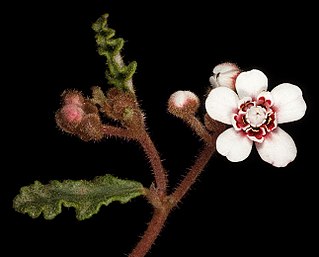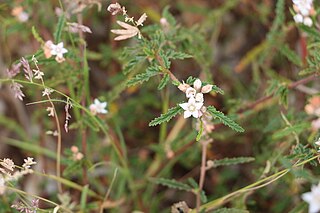
Olearia, most commonly known as daisy-bush, is a genus of flowering plants belonging to the family Asteraceae, the largest of the flowering plant families in the world. Olearia are found in Australia, New Guinea and New Zealand. The genus includes herbaceous plants, shrubs and small trees. The latter are unusual among the Asteraceae and are called tree daisies in New Zealand. All bear the familiar daisy-like composite flowerheads in white, pink, mauve or purple.

Commersonia is a genus of twenty-five species of flowering plants in the family Malvaceae. Plants in this genus are shrubs or trees, occurring from Indochina to Australia and have stems, leaves and flowers covered with star-like hairs. The leaves are simple, often with irregularly-toothed edges, the flowers bisexual with five sepals, five petals and five stamens and the fruit a capsule with five valves. The genus underwent a revision in 2011 and some species were separated from Commersonia, others were added from Rulingia.

Mirbelia is a plant genus belonging to the family Fabaceae and is endemic to Australia, occurring in every mainland state except South Australia. Plants in the genus Mirbelia are prickly, perennial shrubs with simple, sometimes sharply-pointed leaves, or the leaves absent. The flowers are arranged singly or in groups in leaf axils or on the ends of branches, the sepals joined at the base with five teeth. The petals are usually red, orange, purplish or bluish and the fruit is an inflated pod.

Lasiopetalum, commonly known as velvet bushes, is a genus of about forty-five species of flowering plants in the family Malvaceae, all endemic to Australia.
Rulingia is a genus of flowering plants native to Australia and Madagascar. In 2011, all species were transferred to Commersonia with the exception of Rulingia cuneata, R. loxophylla, R. luteiflora and R. procumbens which have been transferred to the new genus Androcalva.

Commersonia dasyphylla, commonly known as kerrawang, is a species of flowering plant of the family Malvaceae and is endemic to eastern continental Australia. It is a shrub with egg-shaped to lance-shaped with irregular edges and flowers in groups of up to 21, followed by hairy brown capsules.

Androcalva fraseri, commonly known as blackfellow's hemp or brush kurrajong, is a species of flowering plant in the family Malvaceae and is endemic to eastern Australia. It is a small tree or shrub that forms suckers and has egg-shaped or lance-shaped leaves with serrated edges, and clusters of 13 to 21 white flowers.

Androcalva rosea, commonly known as Sandy Hollow commersonia, is a small endangered shrub with pink flowers and prostrate trailing branches. It is only known from four locations in the Hunter Valley of New South Wales.

Androcalva pulchella is a shrub in the family Malvaceae. It is native to Western Australia.
Carolyn F. Wilkins is an Australian botanist, who currently works for the Western Australian Department of Biodiversity, Conservation and Attractions.
Androcalva argentea is a species of flowering plant in the family Malvaceae and is endemic to Queensland. It is a tall shrub that forms suckers from rhizomes and has silvery branchlets and leaves, the leaves egg-shaped with wavy edges and serrated, and dense clusters of 10 to 30 white to cream-coloured flowers.
Androcalva beeronensis is a species of flowering plant in the family Malvaceae and is endemic to Queensland. It is a shrub that forms suckers from rhizomes and has branchlets and leaves covered with soft, golden hairs, the leaves egg-shaped to lance-shaped with toothed edges, and clusters of 9 to 24 cream-coloured to white flowers.

Androcalva crispa, commonly known as crisped leaf commersonia, is a species of flowering plant in the family Malvaceae and is endemic to the south-west of Western Australia. It is a prostrate shrub that forms suckers from rhizomes and has densely new growth, clusters of lobed, egg-shaped or oblong leaves with wavy, serrated edges, and groups of white and pinkish-purple flowers.
Androcalva inglewoodensis is a species of flowering plant in the family Malvaceae and is endemic to south-eastern Queensland. It is a spreading, prostrate shrub that has hairy young branchlets, egg-shaped to elliptic leaves with irregularly serrated edges, and small groups of white to cream-coloured flowers.

Androcalva johnsonii is a species of flowering plant in the family Malvaceae and is endemic to central Queensland. It is a low, spreading shrub that has hairy young branches, narrowly egg-shaped or oblong leaves with rounded teeth, and small groups of white to pale pink flowers.
Androcalva leiperi, also known as Leiper's commersonia, is a species of flowering plant in the family Malvaceae and is endemic to a restricted part of south-east Queensland. It is an erect or prostrate shrub that has brown bark, lance-shaped leaves with 4 to 7 pairs of rounded serrations on the edges, and groups of 3 to 12 white flowers.

Androcalva melanopetala is a species of flowering plant in the family Malvaceae and is endemic to southern inland Western Australia. It is a sometimes prostrate shrub that has densely hairy new growth, egg-shaped to elliptic leaves with rounded teeth on the edges, and clusters of white or cream-coloured and pink to red flowers.

Androcalva multiloba is a species of flowering plant in the family Malvaceae and is endemic to the Eyre Peninsula of South Australia. It is a dwarf shrub with densely hairy, irregularly serrated, egg-shaped leaves, and up to 5 white and red flowers arranged opposite leaf axils or on the ends of branches.
Androcalva pearnii is a species of flowering plant in the family Malvaceae and is endemic to the Blackdown Tableland National Park in eastern Queensland. It is shrub that forms suckers and has hairy new growth, wavy, oblong to elliptic leaves with rounded lobes on the edges, and groups of 3 to 8 white and cream-coloured to pale green flowers.

Androcalva pedleyi is a species of flowering plant in the family Malvaceae and is endemic to south-eastern Queensland. It is low, spreading or prostrate shrub that forms suckers and has softly-hairy new growth, linear to lance-shaped leaves with lobes on the edges, and groups of 7 to 10 white, later pink flowers.















